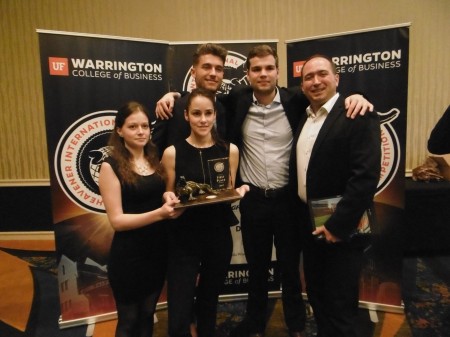So what did we get wrong? – A quick guide to some common mistakes of case solvers
(…and a few tips on how to avoid them)
As those of you who have already participated at case study competitions may know, case study competitions are about a lot more than just coming up with the most creative and effective solution to a given problem. The key ingredients to a winning case study solution include (but are not limited to):
- Creative, detailed solutions
- Clear structure and coherency
- Insightful analysis
- Sound finances
- A solid performance during Q&A
- Pretty slides and an attention to details
- A great team and an engaging presentation style
After the case competition, probably the most common question posed by the members of the non- winning teams is: ‘What did we get wrong? Why did the other team win?’ In my experience – after having seen hundreds of case study presentations – some of the most common mistakes are related to a lack (or not perfect amount/quality) of the above-mentioned key ingredients.
Your solution is bland, superficial or unrealistic.
This is quite obvious: If your solution is just like any other team’s, it will be quite difficult to distinguish yourselves from the others, and keep the interest of the judges. Out-of-the box thinking is highly appreciated in case solving competitions. However, don’t go overboard. Too much creativity often diverts the team’s attention from working out the details of their solutions, and the list of colorful ideas is going to look more like the result of a brainstorming session rather than a case solution. Creative solutions tend to be riskier too, making it even more important to support your ideas with deep implementation. Don’t forget to do a reality check of your solution (is that really expensive marketing campaign really going to double the market share of the company to make it worth the investment?)!
The structure is off.
Judges often have to sit through several presentations in one go, so make sure your presentation is easy to follow if you want to keep their attention. Most teams use a general analysis – alternatives/recommendations – implementation structure, but structuring a presentation has more to it than that. Every presentation is a story: the easiest way to check if your structure is good is to read aloud the action titles of your slides one after the other – if it sounds like a storyboard, then you should be fine. (However, your presentation differs from a regular story in that right in the beginning, you have to tell your audience the end of the story – or in other terms, use top down communication.)
We quite often run into presentations where there is no clear connection between the different sections: the team identifies some issues in the analysis part, then forgets about those by the recommendations part. Make sure that a) your solution tackles the issues identified in the analysis part; b) make the connection clear (e.g. refer back to the issues when presenting your solution to them). Also pay attention to the structure within each section (e.g. you can start your analysis with the external/macro analysis then go gradually down to company level).
The analysis lacks insights.
When coaching teams for case study competitions, I have noticed that after reading the case, teams often start right away by coming up with solutions. The main problem with that is that they forget to answer a key question: solutions to what? Not to mention that without a clear understanding of the industry, macro environment and the workings of the company, your solutions risk being inadequate or unrealistic.
While it is true that a strong analysis will not make you win a competition, a weak one can make you lose it. In their analyses, teams often don’t go beyond what is clearly stated in the case. (As a result of which teams repeat the same things in the analysis part, making it seem like even less important as everybody is saying the same). Do not neglect the analysis: look out for information hidden in the case, check the financial reports and how the key numbers changed over the years, read about the industry and understand the major trends and challenges facing companies in the industry, compare the company’s performance and strategy with its competitors’ and watch out for any outlying data. This way you will not only be able to identify issues and insights that other teams may not find, but also understand what makes the industry and the company tick.
The numbers are not adding up.
Case competitions don’t require you to be a finance guru, so don’t overcomplicate it. A simple income statement for the next 3-5 years (or in some cases a cash flow projection) usually suffice. Judges expect to see how much profit your ideas are going to generate for the company in the next few years (or – especially in case of a non-profit company -, how much it will cost) and where the money will come from. Be realistic with your estimations – blatantly overestimated sales and underestimated costs will be noticed by the judges. If that really cool solution you came up with also turns out to be really unprofitable, don’t just leave it to the finance guy to work some magic with the numbers. Try and think of ways of changing your solution in order to generate more revenues or save costs. Also make sure that the assumptions (e.g. average price, interest rate, average salary, taxes) that you base your calculations on hold up – do not give the opportunity to the judges to point out that the average salary in the given country is actually twice as high, thus making your whole solution crumble.
The team can’t defend their solution in the Q&A.
So the presentation went perfectly, the judges loved your solution – then comes the Q&A part, the first judge fires the first bullet, and suddenly you feel like Napoleon at the Battle of Waterloo. It is quite easy to lose a competition at the Q&A part – many superficial solutions may not be unmasked during the presentation, but the Q&A is exactly for that. If you did your analyses thoroughly, thought through your solution from several perspectives and based your calculations on sound assumptions (and maybe even created back up slides for possible questions), then you should be able to defend your solution.
However, the style of your answers also matters. If you are haughty, attack the judges (even the passive aggressive ‘As I have pointed it out earlier…’ is to be avoided), you can expect to lose points in the Q&A. Too long answers can create the impression that you have no idea what you are talking about, so try to keep them concise. (Read more about the Q&A here.)
The slides are sloppy.
While a case competition is definitely not a beauty pageant for PowerPoint slides, appearances do matter. Sloppy slides riddled with typos might give out the (hopefully) false image that your team is unprofessional and lazy, with a lack of attention to detail. They make it more difficult for judges to pay attention to the content of your slides, and might make them more critical of your presentation altogether. So proofread, proofread and proofread your slides before handing them in. Pay special attention to always spell the name of the company right! Also try to avoid awkward typos (such as pubic vs. public, – no, definitely not the best way to make the judges laugh).
And the list goes on and on… There are quite a lot of ways to trip up during a case solving competition. However, by focusing on avoiding these common mistakes, hopefully your team will beone step closer to that coveted win!
What would you add to the list of major faux pas committed by case solvers? Feel free to share your ideas in the comment section.
Klaudia Vas
Case Solvers trainer


